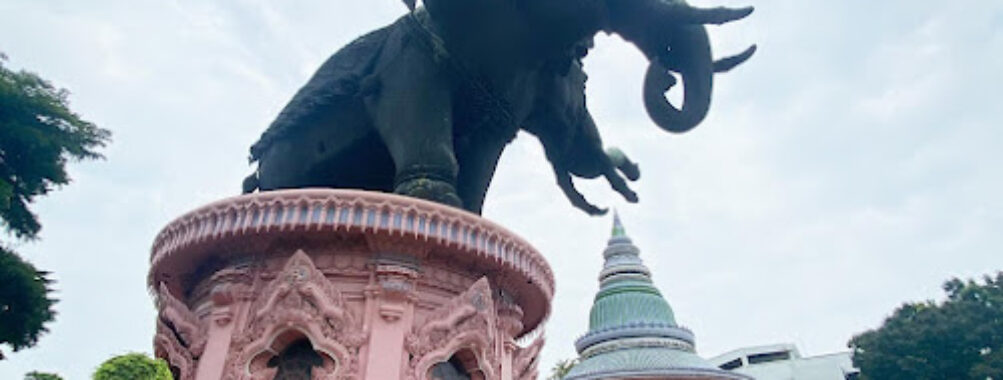
The Erawan Museum
Table of Contents
Description
The Erawan Museum is one of those places that makes you stop in your tracks the moment you see it. Rising above the skyline is a colossal three-headed elephant statue, so big and surreal that it almost feels like you’ve stepped into a myth. And in a way, you have. This museum is more than just a building filled with artifacts – it’s a living piece of Thai culture, spirituality, and artistry wrapped into one. Inside, you’ll find a mix of religious relics, cultural treasures, and architecture that feels like it’s been carefully designed to tell a story. Some visitors walk away awestruck, while others might find it a little overwhelming or even too hot inside (Thailand’s humidity doesn’t hold back). But almost everyone agrees that it’s unlike any other museum they’ve been to.
What I personally love about it is that it’s not just about looking at objects behind glass. Walking through the museum feels like being part of a journey – from the underworld to the heavens – with each floor representing a different spiritual realm. It’s colorful, ornate, and sometimes a little over-the-top, but that’s also what makes it memorable. Whether you’re into history, architecture, or just want to snap a jaw-dropping photo with that massive elephant, the Erawan Museum delivers an experience that sticks with you long after you leave.
Key Features
- Iconic three-headed elephant statue towering over the museum grounds
- Intricately decorated interiors with stained glass, carvings, and symbolic artwork
- Collections of Thai cultural and religious artifacts across multiple floors
- Spiritual journey design, moving from the underworld to heaven
- Wheelchair accessible entrances, restrooms, and parking
- Onsite amenities including a restaurant, restrooms, and family-friendly facilities like changing tables
- Free parking available for visitors driving in
- Peaceful gardens surrounding the museum, perfect for a quiet stroll
Best Time to Visit
If you ask me, mornings are the sweet spot. Arriving right after the museum opens means you’ll skip the harsh midday heat and the larger tour groups that tend to roll in later. The museum is open daily from 9 AM to 6 PM, but the ticket counter closes at 5 PM, so don’t cut it too close. Late afternoons can also be nice if you’re chasing softer light for photos of the elephant statue, though you’ll still want to keep an eye on the heat. Weekdays are generally quieter than weekends, which makes it easier to take your time and really soak in the details without feeling rushed. And if you’re the type who hates crowds (I get it, me too), avoid public holidays when it can get packed.
How to Get There
The Erawan Museum is located in Samut Prakan, just outside of central Bangkok, and it’s surprisingly easy to reach. If you’re already exploring Bangkok, the BTS Skytrain is your best friend – hop on the Sukhumvit Line and get off at Chang Erawan Station. From there, it’s just a short taxi or tuk-tuk ride to the museum. For those who prefer the comfort of a car, taxis and ride-hailing apps like Grab are reliable and fairly inexpensive. If you’re driving yourself, you’ll be happy to know the museum offers free parking. Personally, I like taking the BTS because it avoids Bangkok’s notorious traffic, but if you’re traveling with kids or a group, a direct taxi might be the more convenient choice.
Tips for Visiting
First and foremost, dress comfortably but respectfully. The museum is a spiritual space, so modest clothing is recommended – think covered shoulders and knees. And trust me, you’ll thank yourself for wearing breathable fabrics because it can get hot and humid inside. Bringing a small bottle of water is a good idea, though there’s also a restaurant onsite if you need a proper break.
Photography is allowed, and you’ll definitely want your camera for that massive elephant statue, but be mindful of the sacred areas where it may not be appropriate to pose or snap away. If you’re traveling with kids, you’ll be glad to know the museum is family-friendly, with restrooms and changing tables available. Wheelchair users will also find the site accessible, which isn’t always the case in older Thai attractions, so that’s a big plus.
One more thing – don’t just rush through to take pictures and leave. Slow down, notice the details in the stained glass, the carvings, the way the light filters through the windows. I once spent nearly an hour just sitting in the main hall, watching how the colors shifted as the sun moved. It’s those quiet moments that make a visit feel special. And if you’re combining it with a trip to the nearby Ancient City (which many people do), plan at least half a day so you don’t feel rushed.
In short: go early, dress light but modest, keep an open mind, and give yourself enough time to really appreciate the museum. It’s not just about ticking off another attraction – it’s about stepping into a space that blends art, history, and spirituality in a way that’s uniquely Thai.
Location
Places to Stay Near The Erawan Museum
Find and Book a Tour
Explore More Travel Guides
No reviews found! Be the first to review!